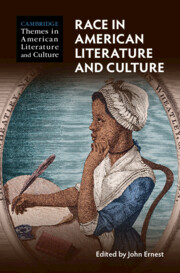Book contents
- Race in American Literature and Culture
- Cambridge Themes in American Literature and Culture
- Race in American Literature and Culture
- Copyright page
- Contents
- Contributors
- Acknowledgments
- Introduction
- Part I Fractured Foundations
- Part II Racial Citizenship
- Part III Contending Forces
- Part IV Reconfigurations
- Part V Envisioning Race
- Chapter 15 Picturing Race
- Chapter 16 “The Man That Was a Thing”
- Chapter 17 Locating Race
- Chapter 18 De-forming and Re-making
- Part VI Case Studies
- Part VII Reflections and Prospects
- Index
Chapter 16 - “The Man That Was a Thing”
Uncle Tom’s Cabin, Photographic Vision, and the Portrayal of Race in the Nineteenth Century
from Part V - Envisioning Race
Published online by Cambridge University Press: 26 May 2022
- Race in American Literature and Culture
- Cambridge Themes in American Literature and Culture
- Race in American Literature and Culture
- Copyright page
- Contents
- Contributors
- Acknowledgments
- Introduction
- Part I Fractured Foundations
- Part II Racial Citizenship
- Part III Contending Forces
- Part IV Reconfigurations
- Part V Envisioning Race
- Chapter 15 Picturing Race
- Chapter 16 “The Man That Was a Thing”
- Chapter 17 Locating Race
- Chapter 18 De-forming and Re-making
- Part VI Case Studies
- Part VII Reflections and Prospects
- Index
Summary
This essay explores the spectacle cast of race in nineteenth-century American literature and culture by way of highlighting an impulse in white writing to represent black figures according to a cultural materialism rooted in the invention of the daguerreotype in 1839. Specifically, it explores the cultural force of daguerreotypy on nineteenth-century US literary and visual portrait cultures. Taking Harriet Beecher Stowe’s Uncle Tom’s Cabin for its touchstone text, “The Man That Was a Thing” argues that under the sway of visual portrait making on the unconscious of US law and literature, the black slave subject like Uncle Tom was portrayed not so much as a person debased into property (as we routinely imagine) so much as living property, a half-thing, made to seem alternately like a person in the sentimental interests of (white) democratic thought. In other words, in Stowe, both the doubly literary and juridical effects of racialized vision on the question of human being follow from a strange technology of words and thought in US law that granted the slave two bodies in early American legal history, as it were – one personal, the other thingly.
Keywords
- Type
- Chapter
- Information
- Race in American Literature and Culture , pp. 262 - 275Publisher: Cambridge University PressPrint publication year: 2022



